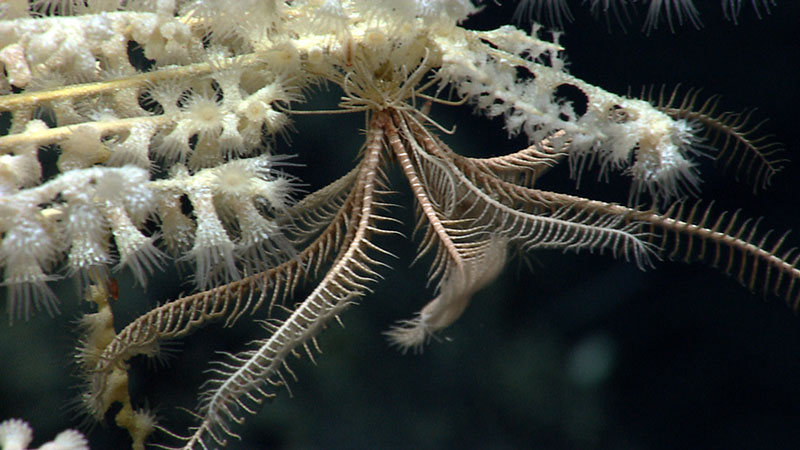
A crinoid or feather star hangs out on a deepwater coral on the south side of Mytilus Seamount. Image courtesy of the NOAA Office of Ocean Exploration and Research, Northeast U.S. Canyons Expedition 2013. Download larger version (jpg, 1.2 MB).

A crinoid or feather star hangs out on a deepwater coral on the south side of Mytilus Seamount. Image courtesy of the NOAA Office of Ocean Exploration and Research, Northeast U.S. Canyons Expedition 2013. Download larger version (jpg, 1.2 MB).
The deep-sea lizard fish (Bathysaurus) was observed on the south side of Mytilus Seamount. This fish sits on the bottom and grabs prey from the water column. Video courtesy of the NOAA Office of Ocean Exploration and Research, Northeast U.S. Canyons Expedition 2013. Download video (mp4, 4.2 MB).
Our fifth dive took place on the south side of Mytilus Seamount and contrasted with the north wall dive in many ways. The remotely operated vehicle (ROV) was on bottom at at 3,262 meters. The terrain was gently sloping sandy sediment with scattered cobbles, including darker-colored manganese-coated basalt and lighter-colored stones, potentially composed of carbonate. More fish were noted duing this dive than were on the north side of the seamount; they were present mostly on the sedimented areas at the beginning and end of the dive. High abundances and diversity of sponges were noted throughout the dive once we ascended to hard substrate, including several types observed on Mytilus dive #4: “tulip” shaped, vase sponges, and some new forms, primarily hexactinellids. A few crustaceans were observed, including hermit crabs with anemone houses, shrimp, and squat lobsters (Munidopisidae). The first coral noted on the dive was a sea pen observed on the sedimented seafloor. The general substrate throughout the dive was composed of large basalt ledges with thin to thick sediment drape, steep rocks, and some smooth basalt pillars transitioning to mostly sediment with cobble at approximately 2,697 meters. Up to 13 octocorals were observed during the dive, including our first observation of Calyptrophora. Three types of black corals were also noted. We noted discrete zonation present on a bamboo coral, with brittle stars, barnacles, and zoanthids covering different sections of the mostly dead coral. A few seastars observed during yesterday’s dive were also noted today, including cf. Evoplosoma (coral eating type), Hymenaster, and Pteraster. At the end of the dive, we noticed a piece of wood that was heavily bored, with squat lobsters perched on one end. The ROV was off bottom at 2126 UTC, leaving from a depth of 2,593 meters.